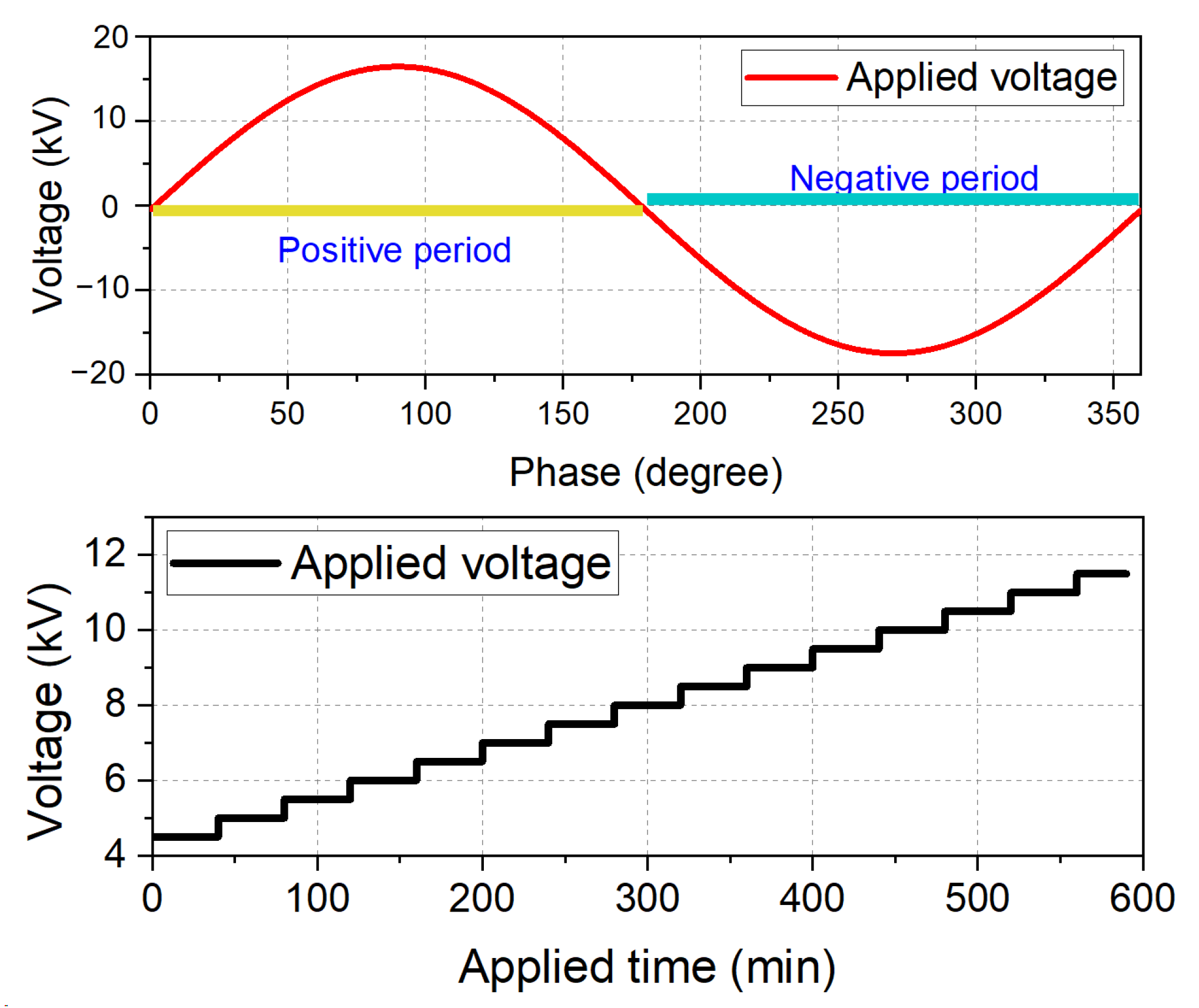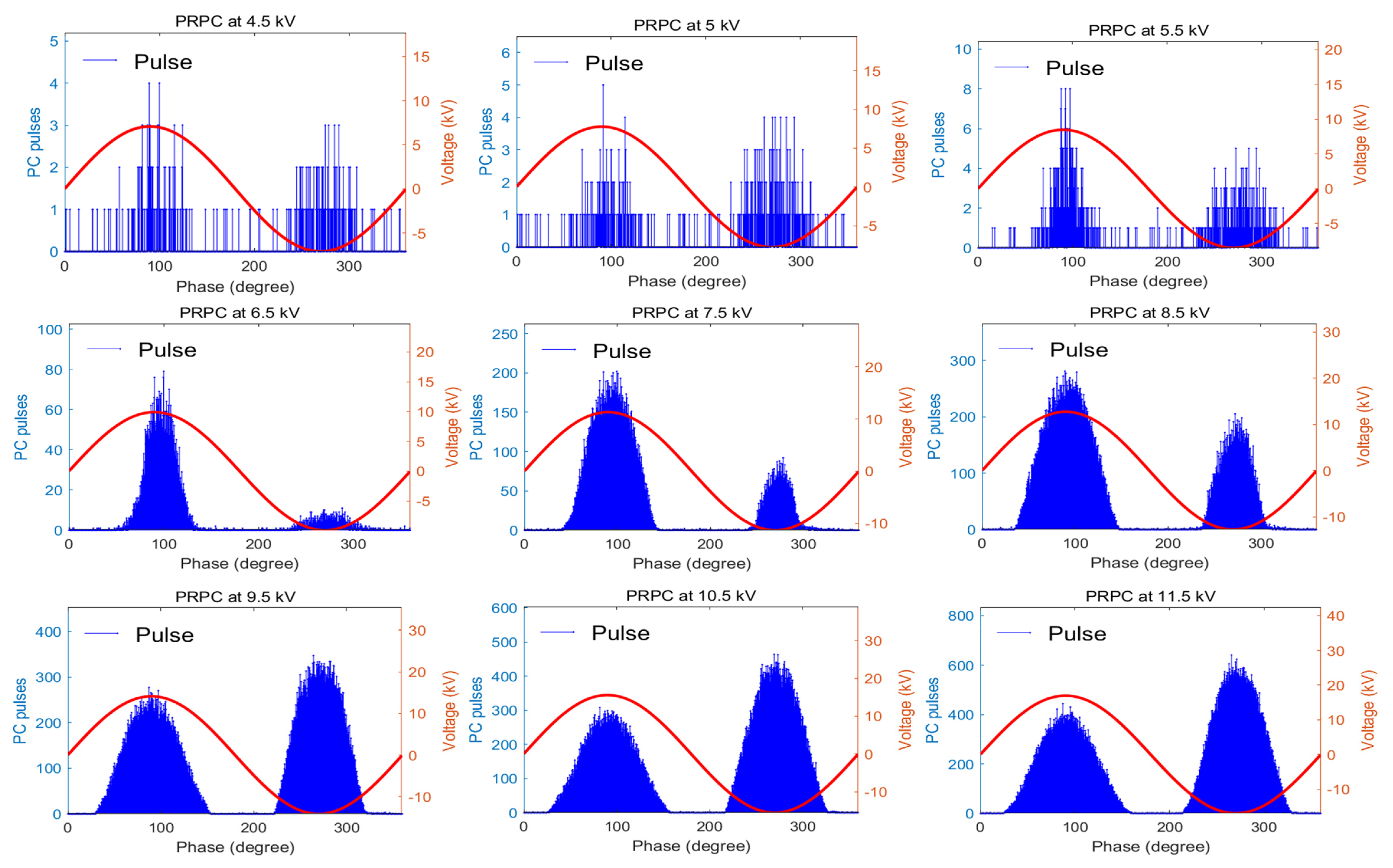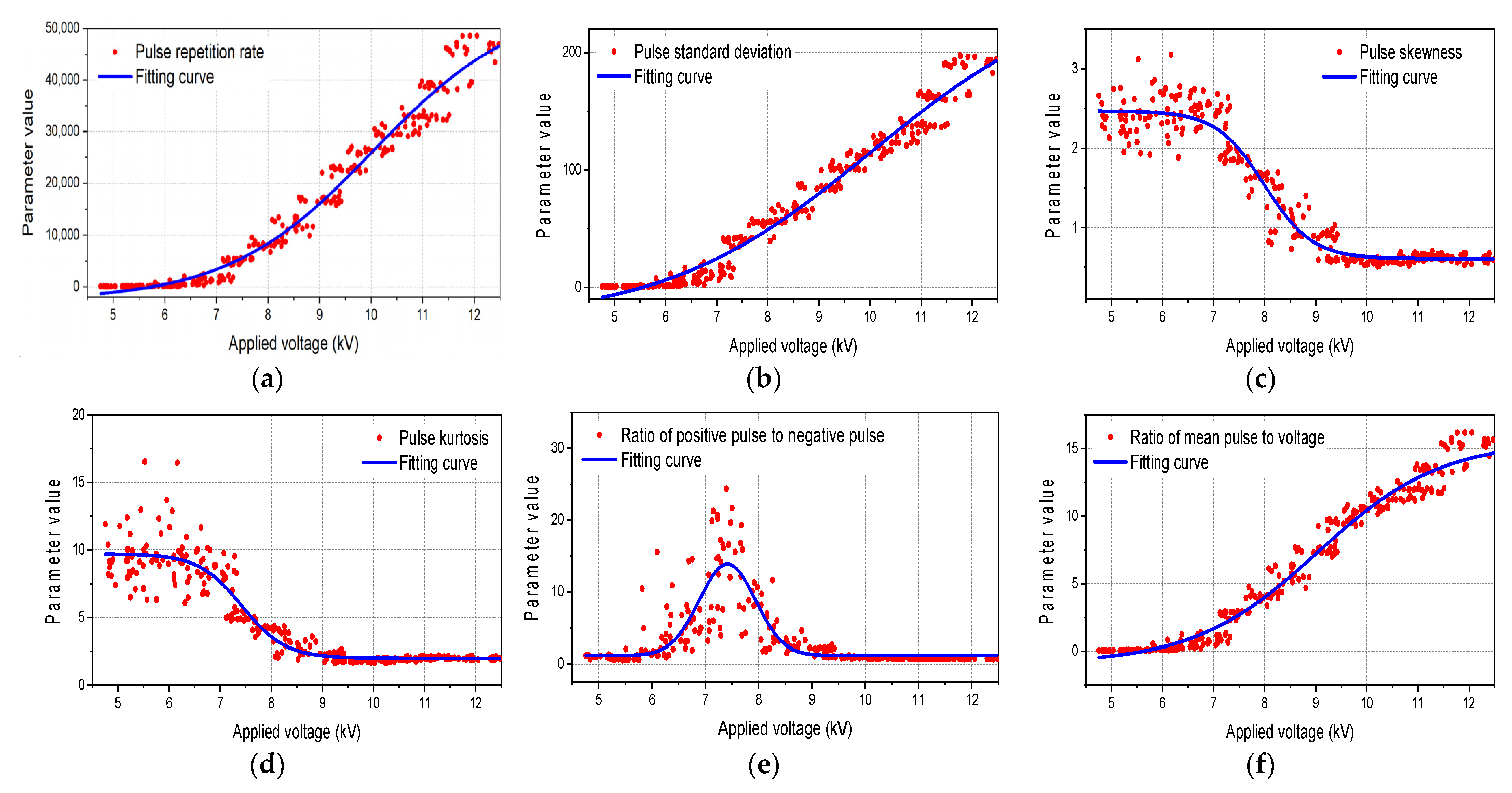Optical Detection and Cluster Analysis of Metal-Particle-Triggered Alternating Current Optical Partial Discharge in SF6
Abstract
1. Introduction
2. Experimental Platform and Measurement Results
2.1. Experimental Platform
2.2. Measurement Results
3. Discharge State Analysis
3.1. Features for Characterizing the PRPC Pattern
3.2. Discharge Pattern Identification
- i.
- Calculate the similarity matrix: Calculate a similarity matrix based on the similarity between each pair of data points in a high-dimensional dataset.
- ii.
- Initialization of embedding space: Randomly initialize a position for each data point in a low-dimensional space.
- iii.
- Define t-distribution probability distribution: Use the t-distribution to define the conditional probability distribution between data points in both the high-dimensional and low-dimensional spaces.
- iv.
- Optimization process: By minimizing the Kullback–Leibler divergence of the conditional probability distribution, adjust the position of the data in the low-dimensional space.
- v.
- Iterative optimization: Iteratively update the position of each data point in the low-dimensional space until the stopping condition is met.
- vi.
- Visualization and analysis: Finally, use the optimized data point positions in the low-dimensional space for visualization and analysis.
4. Conclusions
Author Contributions
Funding
Data Availability Statement
Conflicts of Interest
References
- Li, C.Y.; Lin, C.; Chen, G.; Tu, Y.; Zhou, Y.; Li, Q.; Zhang, B.; He, J. Field-dependent charging phenomenon of HVDC spacers based on dominant charge behaviors. Appl. Phys. Lett. 2019, 114, 202904. [Google Scholar] [CrossRef]
- Wang, F.; Liang, F.; Zhong, L.; Chen, S.; Li, C.; Xie, Y. Short-time X-ray irradiation as a non-contact charge dissipation solution for insulators in HVDC GIS/GIL. IEEE Trans. Dielectr. Electr. Insul. 2021, 28, 704–709. [Google Scholar] [CrossRef]
- Wang, J.; Hu, Q.; Chang, Y.; Wang, J.; Liang, R.; Tu, Y.; Li, C.; Li, Q. Metal particle contamination in gas-insulated switchgears/gas-insulated transmission lines. CSEE J. Power Energy Syst. 2021, 7, 1011–1025. [Google Scholar]
- Albarracin, R.; Robles, G.; Martinez-Tarifa, J.M.; Ardila-Rey, J. Separation of sources in radiofrequency measurements of partial discharges using time-power ratio maps. ISA Trans. 2015, 58, 389–397. [Google Scholar] [CrossRef] [PubMed]
- Meng, X.; Li, X.; Lu, T. Statistical properties of corona current pulses in rod-plane air gap under AC–DC composite voltages. IEEE Trans. Dielectr. Electr. Insul. 2024, 3, 212–221. [Google Scholar] [CrossRef]
- Fan, X.; Niu, S.; Luo, H.; Liang, J.; Liu, F.; Li, W.; Liu, W.; Gao, W.; Huang, Y.; Li, C.; et al. Photon counting technique as a potential tool in micro-defect detection of epoxy insulation pull rod in gas-insulated switchgears. High Volt. 2024, 9, 267–274. [Google Scholar] [CrossRef]
- Pandey, J.C.; Gupta, N. Study of treeing in epoxy-alumina nanocomposites using electroluminescence. IEEE Trans. Dielectr. Electr. Insul. 2019, 26, 648–654. [Google Scholar] [CrossRef]
- Mary, D.; Albertini, M.; Laurent, C. Understanding optical emissions from electrically stressed insulating polymers: Electroluminescence in poly(ethylene terephthalate) and poly(ethylene 2,6-naphthalate) films. J. Phys. D Appl. Phys. 1997, 30, 171–184. [Google Scholar] [CrossRef]
- Baudoin, F.; Mills, D.H.; Lewin, P.L.; Le Roy, S.; Teyssedre, G.; Laurent, C. Modeling electroluminescence in insulating polymers under AC stress: Effect of excitation waveform. J. Phys. D Appl. Phys. 2011, 44, 165402. [Google Scholar] [CrossRef]
- Bamji, S.S.; Bulinski, A.T.; Densley, R.J. Threshold voltage of luminescence and electrical tree inception in low-density polyethylene. J. Appl. Phys. 2008, 16, 1376–1392. [Google Scholar] [CrossRef]
- Qiao, B.; Teyssedre, G.; Laurent, C. Uncover the electroluminescence in wide band gap polymers. J. Phys. D Appl. Phys. 2015, 48, 405102. [Google Scholar] [CrossRef]
- Yang, K.; Zhang, G.-J.; Tu, D.-M.; Yan, Z. Space charge and electroluminescence characteristics of thermally aged LDPE films. Appl. Surf. Sci. 2008, 255, 2735–2739. [Google Scholar] [CrossRef]
- Ren, M.; Song, B.; Zhuang, T.X.; Yang, S.J. Optical partial discharge diagnostic in SF6 gas insulated system via multi-spectral detection. ISA Trans. 2018, 75, 247–257. [Google Scholar] [CrossRef] [PubMed]
- Xia, C.J.; Ren, M.; Chen, R.F.; Yu, J.; Li, C.; Chen, Y.; Wang, K.; Wang, S.; Dong, M. Multispectral optical partial discharge detection, recognition, and assessment. IEEE Trans. Instrum. Meas. 2022, 71, 7002921. [Google Scholar] [CrossRef]
- Fan, X.; Luo, H.; Liang, F.; Hu, J.; Liu, W.; Li, C.; He, J. Photon count technique as a potential tool for insulation micro defect detection: Principles and primary results. iEnergy 2023, 2, 258–263. [Google Scholar] [CrossRef]
- Fan, X.; Liang, F.; Luo, H.; Zhang, X.; Huang, Z.; Li, C.; He, J. Detection of defect-induced luminescence in epoxy-based insulation materials via phase resolved photon counting method. J. Phys. D Appl. Phys. 2024, 57, 35. [Google Scholar] [CrossRef]
- Pezzotti, N.; Lelieveldt, B.P.F.; van der Maaten, L.; Hollt, T.; Eisemann, E.; Vilanova, A. Approximated and user steerable tSNE for progressive visual analytics. IEEE Trans. Vis. Comput. Graph. 2017, 23, 1739–1752. [Google Scholar] [CrossRef]
- Nakano, Y.; Kozako, M.; Hikita, M.; Tanaka, T.; Kobayashi, M. Estimation method of degraded vacuum in vacuum interrupter based on partial discharge measurement. IEEE Trans. Dielectr. Electr. Insul. 2019, 26, 1520–1526. [Google Scholar] [CrossRef]
- Chen, Y.; Zhao, M.; Liu, Z.; Ma, J.; Yang, L. Comparative analysis of offshore wind resources and optimal wind speed distribution models in China and Europe. Energies 2025, 18, 1108. [Google Scholar] [CrossRef]
- Zampolo, R.F.; Lopes, F.H.R.; de Oliveira, R.M.S.; Fernandes, M.F.; Dmitriev, V. Dimensionality Reduction and Clustering Strategies for Label Propagation in Partial Discharge Data Sets. Energies 2024, 17, 5936. [Google Scholar] [CrossRef]
- Ji, S.; Ye, J. Generalized linear discriminant analysis: A unified framework and efficient model selection. IEEE Trans. Neural Netw. 2008, 19, 1768–1782. [Google Scholar] [PubMed]
- Howland, P.; Park, H. Generalizing discriminant analysis using the generalized singular value decomposition. IEEE Trans. Pattern Anal. Mach. Intell. 2004, 26, 995–1006. [Google Scholar] [CrossRef] [PubMed]
- Fan, X.; Luo, H.; Liang, F.; Ma, T.; Hu, J.; Li, C.; He, J. Feature fusion of pulse current, ultrahigh frequency, and photon count signal: A novel discharge pattern recognition method of metal particles in GIS/GIL. IEEE Sens. J. 2024, 24, 36979–36986. [Google Scholar] [CrossRef]





| Item | Discharge State | ||
|---|---|---|---|
| SD | MD | SED | |
| Classification center | (0.16, 0.59, 0.90) | (0.66, 0.96, 0.09) | (0.80, 0.10, 0.25) |
| Included voltages (kV) | 4.5 to 6.5 | 7.0 to 8.5 | 9.0 to 11.5 |
Disclaimer/Publisher’s Note: The statements, opinions and data contained in all publications are solely those of the individual author(s) and contributor(s) and not of MDPI and/or the editor(s). MDPI and/or the editor(s) disclaim responsibility for any injury to people or property resulting from any ideas, methods, instructions or products referred to in the content. |
© 2025 by the authors. Licensee MDPI, Basel, Switzerland. This article is an open access article distributed under the terms and conditions of the Creative Commons Attribution (CC BY) license (https://creativecommons.org/licenses/by/4.0/).
Share and Cite
Luo, H.; Liu, Y.; Guo, C.; Liang, Z. Optical Detection and Cluster Analysis of Metal-Particle-Triggered Alternating Current Optical Partial Discharge in SF6. Energies 2025, 18, 1649. https://doi.org/10.3390/en18071649
Luo H, Liu Y, Guo C, Liang Z. Optical Detection and Cluster Analysis of Metal-Particle-Triggered Alternating Current Optical Partial Discharge in SF6. Energies. 2025; 18(7):1649. https://doi.org/10.3390/en18071649
Chicago/Turabian StyleLuo, Hanhua, Yan Liu, Chong Guo, and Zuodong Liang. 2025. "Optical Detection and Cluster Analysis of Metal-Particle-Triggered Alternating Current Optical Partial Discharge in SF6" Energies 18, no. 7: 1649. https://doi.org/10.3390/en18071649
APA StyleLuo, H., Liu, Y., Guo, C., & Liang, Z. (2025). Optical Detection and Cluster Analysis of Metal-Particle-Triggered Alternating Current Optical Partial Discharge in SF6. Energies, 18(7), 1649. https://doi.org/10.3390/en18071649






